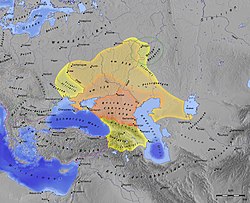Our website is made possible by displaying online advertisements to our visitors.
Please consider supporting us by disabling your ad blocker.
Khazars
Khazar Khaganate Xəzər Xaqanlığı | |||||||||||||
|---|---|---|---|---|---|---|---|---|---|---|---|---|---|
| c. 650–969 | |||||||||||||
 Khazar Khaganate, 650–850 | |||||||||||||
| Status | Khazar Khaganate | ||||||||||||
| Capital | |||||||||||||
| Common languages | Khazar | ||||||||||||
| Religion | |||||||||||||
| Qaghan | |||||||||||||
• 618–628 | Tong Yabghu | ||||||||||||
• 9th century | Bulan | ||||||||||||
• 9th century | Obadiah | ||||||||||||
• 9th century | Zachariah | ||||||||||||
• 9th century | Manasseh | ||||||||||||
• 9th century | Benjamin | ||||||||||||
• 10th century | Aaron | ||||||||||||
• 10th century | Joseph | ||||||||||||
• 10th century | David | ||||||||||||
• 11th century | Georgios | ||||||||||||
| History | |||||||||||||
• Established | c. 650 | ||||||||||||
| 969 | |||||||||||||
| Area | |||||||||||||
| 850 est.[3] | 3,000,000 km2 (1,200,000 sq mi) | ||||||||||||
| 900 est.[4] | 1,000,000 km2 (390,000 sq mi) | ||||||||||||
| Population | |||||||||||||
• 7th century[5] | 1,400,000 | ||||||||||||
| Currency | Yarmaq | ||||||||||||
| |||||||||||||
The Khazars were a semi-nomadic Turkic people. They formed an empire called Khazaria in Russia from the 6th to 10th century CE.[6] They came from the Western Turkic Khaganate of the Eurasian steppe.[7]
Khazaria was an international trading center. It was an important place on the Silk Road that linked China, the Middle East, and the Kievan Rus'.[8][9] For three centuries (c. 650–965) the Khazars conquered the area from the Volga-Don steppes to Crimea and the Caucasus.[8]
Khazaria was between the Byzantine Empire, the steppe nomads, and the Umayyad Caliphate. It helped Byzantine defend itself from the Sasanian Persian empire. The alliance ended around 900.[8] Between 965 and 969, the Kievan Rus replaced Khazaria.
Tengrism may have been the main religion, as it was for the Huns and Turkic peoples.[10] Abrahamic religions were also popular.[10] The ruling class may have converted to Judaism in the 8th century.[11]
Some people think that the Cossacks, Muslim Kumyks, Kazakhs, and some Jews, like the Ashkenazi Jews, descended from the Khazars.[12][13][14] Some disagree.[15][16][17][18]
- ↑ Wexler 1996, p. 50
- ↑ Brook, pp. 107
- ↑ Turchin, Peter; Adams, Jonathan M.; Hall, Thomas D (December 2006). "East-West Orientation of Historical Empires". Journal of World-systems Research. 12 (2): 222. ISSN 1076-156X. Retrieved 16 September 2016.
- ↑ Rein Taagepera (September 1997). "Expansion and Contraction Patterns of Large Polities: Context for Russia". International Studies Quarterly. 41 (3): 496. doi:10.1111/0020-8833.00053. JSTOR 2600793.
- ↑ Herlihy 1972, pp. 136–148;Russell1972, pp. 25–71. This figure has been calculated on the basis of the data in both Herlihy and Russell's work.
- ↑ "Khazar | people". Encyclopedia Britannica. Retrieved 2018-07-30.
- ↑ Sneath 2007
- ↑ 8.0 8.1 8.2 Noonan 1999
- ↑ Golden 2011
- ↑ 10.0 10.1 Golden 2007a
- ↑ 2007aGolden 2007a
- ↑ Kizilov 2009
- ↑ Patai & Patai 1987
- ↑ Wexler 1987
- ↑ Wexler 2002: 'Most scholars are sceptical about the hypothesis (that has its roots in the late 19th century) that Khazars became a major component in the ethnogenesis of the Ashkenazic Jews'.
- ↑ Rubin 2013.
- ↑ Davies 1992
- ↑ Vogt 1975.
Previous Page Next Page


